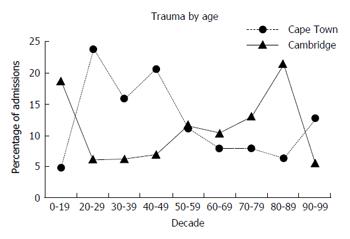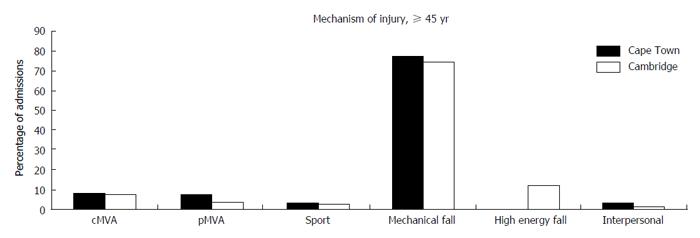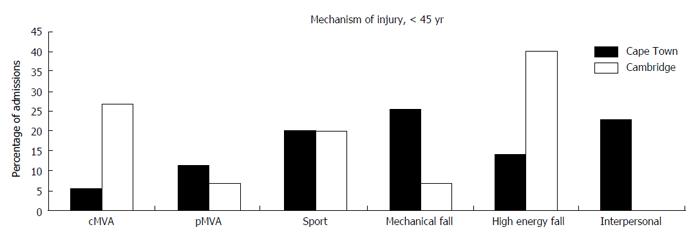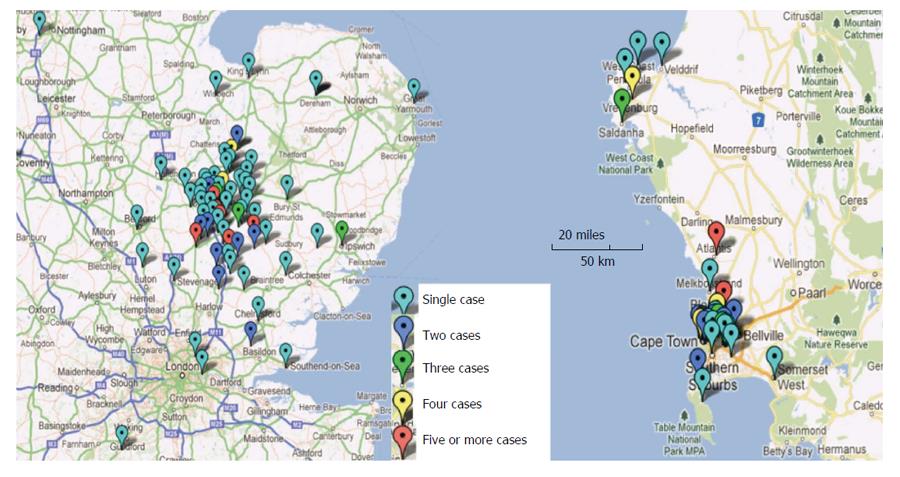Published online May 18, 2016. doi: 10.5312/wjo.v7.i5.308
Peer-review started: November 25, 2015
First decision: December 28, 2015
Revised: January 6, 2016
Accepted: March 7, 2016
Article in press: March 9, 2016
Published online: May 18, 2016
AIM: To compare the trauma experience gained by a trainee at a United Kingdom major trauma centre and a secondary level hospital in South Africa.
METHODS: A profile of inpatient trauma cases during a five-week period in Addenbrooke’s Hospital, Cambridge and Somerset Hospital, Cape Town was created. This was achieved by recording various parameters for each patient admitted including age, gender, injury, mechanism of injury and postal/area code. This, together with details of the departments themselves, allows a comparison of the amount and variety of orthopaedic trauma cases experienced by an individual trainee in each setting.
RESULTS: The trauma profiles differed significantly. Patients in Cape Town were younger and more likely to be male. In the young, injury in Cape Town was more likely to occur due to assault or being struck by a vehicle, whilst patients in Cambridge were more likely to be injured whilst in a vehicle or in high energy falls. In older patients, trauma at both centres was almost exclusively due to mechanical falls. In a given age group, injuries at the two centres were similar, however the majority of patients admitted to Addenbrooke’s were elderly, resulting in less variation in the overall injury profile.
CONCLUSION: The trauma profile of a major trauma centre in the United Kingdom is less varied than that of a South African secondary centre, with significantly fewer cases per surgeon. This suggests a more varied training experience in the developing world with a greater caseload.
Core tip: The caseload of a hospital directly impacts the training experience of a surgeon. Centres in the developing world are widely thought to offer a superior exposure to traumatic injury and consequently a rich training environment for the orthopaedic trainee. This study directly compares the caseload at two centres over a fixed period, and shows that the department in the developing world experienced greater volume and variation in trauma cases thereby offering a better experience for training in trauma.
- Citation: Lawrence JE, Khanduja V. From Cape Town to Cambridge: Orthopaedic trauma in contrasting environments. World J Orthop 2016; 7(5): 308-314
- URL: https://www.wjgnet.com/2218-5836/full/v7/i5/308.htm
- DOI: https://dx.doi.org/10.5312/wjo.v7.i5.308
Injury secondary to trauma is a major public health issue. It is a leading cause of death world wide, with road traffic accidents alone accounting for 1.2 million deaths per year[1]. By 2020, musculoskeletal injury will account for 20% of all the world’s disability-adjusted life years. The vast majority of this burden lies with the developing world with low and middle-income countries entering the third phase of epidemiologic transition. This entails an increase in the average life expectancy and a consequent exposure of the population to the so-called man-made diseases[2-4]. Despite this growing burden, orthopaedic care in the developing world remains scarce when compared with developed countries, with only one in three people provided for[5].
This disparity in demand and supply of orthopaedic care has implications for orthopaedic training across the globe. This study profiled the orthopaedic trauma admissions at two centres in contrasting settings; one a major trauma centre in Cambridge, United Kingdom, the other a secondary level centre in Cape Town, South Africa. These two counties exemplify the difference in disease burden, with injury accounting for 2.7% and 9% of deaths respectively[6,7]. A comparison would therefore make it possible to quantify how this increased burden in the developing world influences the experience of the orthopaedic trainee in South Africa in comparison with the trainee in the United Kingdom.
The aim of the study, therefore, was to compare, contrast and objectively quantify the trauma admissions that a trainee would be exposed to whilst based in Cambridge, United Kingdom and in Cape Town, South Africa. This in turn would have implications for those intending to train in trauma surgery.
New Somerset Hospital is a secondary level state hospital situated in Green Point, a district in the northwest of Cape Town. It serves the central health district of the city, which holds a population of 800000. The orthopaedic department is staffed by one full-time Consultant, one part-time consultant and two medical officers (equivalent to the core surgical trainee in the United Kingdom). Two internship doctors (equivalent to foundation programme year one doctors) staff the ward, which consists of twenty-three beds; three bays of six patients and one bay of five patients. Each bay is staffed by a staff nurse, with a ward sister overseeing care on the ward. The department admits all patients aged 13 or over, with paediatric cases referred to the regional paediatric hospital.
By contrast, Addenbrooke’s Hospital is the major trauma centre for the East of England, providing tertiary trauma care to a population of 5.4 million. It has seventy-two orthopaedic beds and is staffed by sixteen Consultants, ten specialist registrars and eight senior house officers (a mix of foundation year two doctors, core surgical trainees and junior clinical fellows). The wards consist of several bays and side rooms with one trained nurse for every five patients and senior and junior sisters for each ward. In addition, the department is staffed by a team of three trauma specialist nurses who co-ordinate admissions and administer specialist nursing care on the wards. The Department has a recently expanded and now houses an Orthopaedic Trauma Unit that is run by 5 Consultants specialising in Trauma and essentially manages all the multiply injured patients admitted to the Hospital. The unit admits patients of all ages.
The period of the study at New Somerset Hospital ran during from June to July 2012, and the study at Addenbrooke’s Hospital in Cambridge ran from August to September 2012.
This was a prospective study that included all the orthopaedic trauma admissions during a five-week period at each hospital. For each admitted patient, a multitude of parameters were recorded in order to form an overall profile of the orthopaedic trauma. These were age, sex, injury by anatomical site, mechanism of injury [mechanical fall, high energy fall, sporting, interpersonal, pedestrian motor vehicle accident and in - car motor vehicle accident (cMVA)] and postal/area code.
Statistical analysis was carried out using SPSS Version 13 for all the variables.
There were 63 orthopaedic trauma admissions to the New Somerset Hospital during the study period; 40 males and 23 females with a mean age of 44.9 years. The youngest patient admitted was 14 and the oldest 96. The highest rate of admissions was observed in the 20-29 years age group.
Addenbrooke’s Hospital admitted 144 patients during the study period with equal numbers of male and female patients and a mean age of 54.8 years (range 1 to 97 years), with the highest admission rate in the 80-89 age group. Of these patients, 125 were aged 13 or older, and the average age in this group was 62.4 years. The age distribution of trauma at the two centres is shown in Figure 1.
Injury was catagorised by anatomical region using the AO fracture classification. At New Somerset, tibial fractures were the most common (n = 22, 34.9%), particularly those involving the diaphysis and malleoli, followed by fractures of the proximal femur (n = 11, 17.5%) and fractures of the radius and ulna (n = 10, 15.9%).
At Addenbrooke’s hospital, fractures of the proximal femur were the most common injury (n = 50, 34.7%), followed by fractures of the tibia (n = 24, 16.7%) and fractures of the radius and ulna (n = 23, 16%). The common fracture sites for both centres are compared in Figure 2. Table 1 shows the mean age for the common injury sites at both centres.
| Injury site | Mean patient age - Cambridge (n) | Mean patient age - Cape Town (n) |
| Proximal radius and ulna | 45.8 (6) | 35.6 (5) |
| Distal radius and ulna | 25.3 (12) | 42.3 (4) |
| Intracapsular neck of femur | 81.9 (16) | 74.5 (6) |
| Extracapsular neck of femur | 80.8 (27) | 78.2 (5) |
| Proximal tibia | 47.5 (4) | 26.4 (5) |
| Tibial/fibular diaphysis | 37.1 (7) | 42.1 (8) |
| Tibia/fibula | 44.8 (12) | 49.8 (7) |
Mechanism of injury was divided into six categories. The frequency of each of these categories, together with the mean age for each mechanism, is summarised in Table 2.
| Mechanism | Patients - Cambridge (%) | Mean age (yr) - Cambridge | Patients - Cape Town (%) | Mean age (yr) - Cape Town |
| Mechanical fall | 76 (52.8) | 71.5 | 30 (47.6) | 57.7 |
| High energy fall | 31 (21.5) | 36.9 | 5 (7.9) | 28.2 |
| cMVA | 16 (11.1) | 45.4 | 4 (6.3) | 41.5 |
| pMVA | 6 (4.2) | 39.2 | 6 (9.5) | 39.3 |
| Interpersonal | 1 (0.7) | 68 | 10 (15.9) | 34 |
| Sporting | 15 (10.4) | 22.2 | 8 (12.7) | 26.8 |
Mechanical fall was the most common mechanism of injury for both centres, accounting for 52.8% of injuries at Addenbrooke’s and 47.6% of injuries at New Somerset. High-energy falls were the second most common mechanism at Addenbrooke’s (21.5%), followed by in - cMVAs (11.1%). Interpersonal mechanisms were the second most common at New Somerset (15.9%), followed by sporting incidents (12.7%). Mechanisms of injury in the under-45 and 45 and over age groups at both centres are shown in Figure 3. Mechanical falls (25.7%) and interpersonal actions (22.9%) were the most common cause of injury in the under-45 s in Cape Town, with high-energy falls (40%) and in - cMVAs (26.7%) the most common in this age group in Cambridge.
In the over-45 age group, mechanical falls were the main mechanism, accounting for 74.5% and 77.8% of injuries in Cambridge and Cape Town respectively. These trends are summarized in Figure 3.
Location was recorded at each admission using patient postal code. At New Somerset, the mean distance from patient address to hospital was 21.1 miles, with the median distance 11 miles. Distances ranged from 1 mile to 93 miles. The mean distance between patient address and Addenbrooke’s hospital was 18.6 miles and the median distance was 13.5 miles. Distances ranged from 2 miles to 98 miles.
Geographical distribution of trauma cases is summarized in Figure 4. The distances at Addenbrooke’s Hospital were more normally distributed, whereas the distances at New Somerset Hospital were more positively skewed with a second group of admissions corresponding to outreach services provided by the hospital.
The trauma profile at Addenbrooke’s hospital, Cambridge was markedly different to that of New Somerset Hospital, Cape Town. Patients at New Somerset were younger and more likely to be male. In both centres, there was a similar injury pattern in any given age group, with a notably broader range of injury in younger patients. However, the patients admitted to New Somerset Hospital were of lower average age, resulting in a much more varied overall injury profile at this centre.
Patients in the younger age groups admitted to New Somerset Hospital were more likely to be injured by interpersonal means or following pedestrian motor vehicle accidents than patients in the same age group admitted to Addenbrooke’s Hospital, who were more likely to be injured following an in - cMVA or a high energy fall. These differences reflect the hospitals and their settings; Addenbrooke’s Hospital is a level one trauma centre and is therefore specifically tasked with treating more high energy trauma injuries such as those sustained during in-car motor vehicle accidents or high energy falls. Conversely, new Somerset Hospital serves an area with high rates of interpersonal crime, leading to more injuries sustained by these mechanisms. In the elderly, trauma at both centres was almost exclusively due to mechanical falls with the majority of injuries being fragility fractures.
The geographical distribution of cases at the two centres was comparable, with a similar average distance and range of distances between patient address and hospital. The distances between patient address and Addenbrooke’s Hospital were more normally distributed than those at New Somerset Hospital. This is in keeping with the role of Addenbrooke’s Hospital as a major trauma centre, taking referrals from all parts of the East of England. The distribution of distances between patient address and New Somerset Hospital showed a clear bimodal distribution. These two groups reflect the two distinct areas served by the hospital; the first being western and central Cape Town and the second corresponding to patients admitted from outreach clinics in rural communities far from the hospital (Figure 5).
In order to fully analyse the experience of a trainee, these trauma profiles must be placed in the context of the two centres. Although Addenbrooke’s Hospital admitted more than twice the number of patients than New Somerset Hospital, it employs a significantly larger workforce, with a total of thirty-four surgeons (eighteen trainees, sixteen consultants) to New Somerset’s four (two trainees, one full-time consultant and one part-time consultant). This imbalance in the number of surgeons results in a much greater trauma caseload for the trainee in Cape Town, South Africa. This, together with the more varied injury profile at New Somerset Hospital, enables the trainee to gain wider experience in the management of orthopaedic trauma.
Whilst caseload is an important aspect of surgical training, it is not the sole determinant of its quality. The training programmes in both countries follow the traditional apprenticeship model and are largely comparable, with some subtle differences which should be understood when comparing the experience gained by a trainee. In South Africa, orthopaedic training is undertaken following a two year internship and community service year. Training takes place at one of nine accredited universities, two of which are accredited for the first two years of the training programme only. This is similar to the structure of training in the United Kingdom which takes place in one of twelve regions in England, Wales and Northern Ireland (Scotland has a separate training structure). Each region contains at least one teaching hospital linked to a university. United Kingdom medical graduates undertake a two-year foundation training programme analogous to that of the South African internship, however there is no equivalent to the community service year in the United Kingdom. Instead, trainees must complete the two-year core surgical training programme before applying for specialty training in orthopaedics.
Both South African and United Kingdom orthopaedic specialty training programmes typically last for five years, and require the completion of various examinations in order to progress. In South Africa, training works on the basis of three levels of study. The first level is assessed with the primary examination, which focuses on basic surgical sciences such as pathology and anatomy. The second level of study concludes with the orthopaedic intermediate examination, which focuses on the clinical aspects of surgery, with a focus on orthopaedics. Enrollment in the intermediate examination requires candidates to have eighteen months of experience in one of the aforementioned university hospitals, including intensive care and trauma experience. The final part of training involves six month rotations through the various orthopaedic sub-specialties with attachment to a consultant for each rotation. During this part of training, trainees must publish at least one research article. Upon completion of three years of rotations, trainees may register for the final examinations, the fellowship of the college of orthopaedic surgeons of South Africa, meaning a surgeon can be fully qualified eight years after graduation from medical school.
Orthopaedic specialty training in the United Kingdom follows a similar pattern, though trainees must attain Membership of the Royal College of Surgeons (MRCS) prior to the commencement of specialist training. This involves passing two examinations; the first a written exam with a focus on basic surgical sciences and principles of surgery in general and the second an objective structured clinical examination which focuses on applied surgical sciences with practical and communication skills. In this regard, the MRCS is comparable to a combination of the primary and intermediate examinations in South Africa, though it lacks specificity to orthopaedics. In a similar fashion to South Africa, the training programme lasts for five years and involves six month rotations through sub-specialties with attachment to a consultant. Like South Africa, trainees take the Fellowship of the Royal College of Surgeons after three or four years of specialty training. Trainees are expected to regularly partake in research and quality improvement. Overall, trainees can be expected to complete training nine to ten years post-graduation[8,9].
Both training programmes have a set of competencies which are expected to be achieved at the completion of training. This essentially requires trainees to be competent in a range of orthopaedic procedures, with competency defined as the completion of a defined number of cases.
The apprenticeship nature of surgical training means much depends on the quality of the mentor, meaning there will always be natural variation in the quality of training. However, the similarity of the training programmes in these two countries places emphasis on the quantity and type of orthopaedic trauma experienced by a trainee. This study shows trainees at Addenbrooke’s Hospital experience fewer cases than their counterparts at New Somerset Hospital, and the cases they do experience are less varied.
To this end, the study highlights the potential benefits of establishing training programmes that combines the structure of a United Kingdom major trauma centre with the volume and variation provided by hospitals in the developing world. Currently, trainees in the United Kingdom are able to apply to their regional training body for out of programme clinical experience (OOPE), which can take the form of work in the developing world. Whilst studies such as ours highlight the potential benefits this would hold for the trainee, time out of programme does not often gain approval for clinical training and thus can delay career progression, making it an unpopular choice amongst trainees.
An alternative to OOPE is an approved fellowship abroad. Several studies have shown the benefits of establishing synergistic partnerships between hospitals in the developing and developed worlds, whereby trainees from each centre swap roles in order to broaden their surgical experience[10,11]. We believe that expanding the number and variety of such fellowships will help surgeons worldwide to establish best practices and increase the standard of trauma care in a time when traumatic injury is increasing at an alarming rate.
Traumatic injury is rapidly increasing in the developing world as many countries enter the third phase of epidemiological transition. This has wide-ranging implications for surgical training, with trainees in the developing world thought to gain greater experience in the management of orthopaedic trauma. The study aimed to compare the experience gained in orthopaedic trauma at United Kingdom major trauma centre and a secondary level South African centre.
Restrictions on working hours have placed additional strain on the training of surgeons, and this study suggests a potential mutual benefit lies in training periods spent in the developing world.
This is the first study to directly compare the orthopaedic trauma experience gained in South African and United Kingdom hospitals, showing a greater caseload with more variation in South Africa. The study adds to the literature on the utility of out of programme experience and exchange fellowships.
This study supports the expansion of both out of programme experience and exchange fellowships in trauma and orthopaedic training.
Out of programme experience: Time spent by a United Kingdom trainee away from their training institution.
The authors have performed a good study, the manuscript is interesting.
P- Reviewer: Anand A, Finestone AS, Luo XH S- Editor: Qiu S L- Editor: A E- Editor: Liu SQ
| 1. | World Health Organization. World health report 2002. Statistical annex 3: burden of disease in DALYs by cause, sex and mortality stratum in WHO regions 2001; Available from: http//www.who.int/whr/2002/annex/en/. [Cited in This Article: ] |
| 2. | Spiegel DA, Nduaguba A, Cherian MN, Monono M, Kelley ET. Deficiencies in the availability of essential musculoskeletal surgical services at 883 health facilities in 24 low- and lower-middle-income countries. World J Surg. 2015;39:1421-1432. [PubMed] [DOI] [Cited in This Article: ] [Cited by in Crossref: 16] [Cited by in F6Publishing: 19] [Article Influence: 2.1] [Reference Citation Analysis (0)] |
| 3. | Moroz PJ, Spiegel DA. The World Health Organization’s action plan on the road traffic injury pandemic: is there any action for orthopaedic trauma surgeons? J Orthop Trauma. 2014;28 Suppl 1:S11-S14. [PubMed] [DOI] [Cited in This Article: ] [Cited by in Crossref: 9] [Cited by in F6Publishing: 12] [Article Influence: 1.2] [Reference Citation Analysis (0)] |
| 4. | Murray CJL, Lopez AD. Global Burden of Disease and Injury Series, vol II. 1996; Available from: http//apps.who.int/iris/bitstream/10665/41864/1/0965546608_eng.pdf. [Cited in This Article: ] |
| 5. | Brouillette MA, Kaiser SP, Konadu P, Kumah-Ametepey RA, Aidoo AJ, Coughlin RC. Orthopedic surgery in the developing world: workforce and operative volumes in Ghana compared to those in the United States. World J Surg. 2014;38:849-857. [PubMed] [DOI] [Cited in This Article: ] [Cited by in Crossref: 22] [Cited by in F6Publishing: 21] [Article Influence: 2.1] [Reference Citation Analysis (0)] |
| 6. | Bradshaw D, Pillay-Van Wyk V, Laubscher R, Nojilana B, Groenewald P, Nannan N, Metcalf C. Cause of death statistics for South Africa: Challenges and possibilities for improvement. Cape Town, SA: Medical Research Council 2012; Available from: http//www.mrc.ac.za/bod/cause_death_statsSA.pdf. [Cited in This Article: ] |
| 7. | Office for National Statistics. Deaths Registered in England and Wales. 2010; Available from: http//www.ons.gov.uk/ons/rel/vsob1/mortality-statistics--deaths-registered-in-england-and-wales--series-dr-/2011/stb-deaths-registered-in-england-and-wales-in-2011-by-cause.html. [Cited in This Article: ] |
| 8. | The Royal College of Surgeons. England Emergency Surgery: Standards for Unscheduled Care. 2011; Available from: http//www.rcseng.ac.uk/publications/docs/emergency-surgery-standards-for-unscheduled-care. [Cited in This Article: ] |
| 9. | Inaparthy PK, Sayana MK, Maffulli N. Evolving trauma and orthopedics training in the UK. J Surg Educ. 2013;70:104-108. [PubMed] [DOI] [Cited in This Article: ] [Cited by in Crossref: 12] [Cited by in F6Publishing: 10] [Article Influence: 0.9] [Reference Citation Analysis (0)] |
| 10. | Hoehn RS, Davis BR, Huber NL, Edwards MJ, Lungu D, Logan JM. A systematic approach to developing a global surgery elective. J Surg Educ. 2015;72:e15-e20. [PubMed] [DOI] [Cited in This Article: ] [Cited by in Crossref: 28] [Cited by in F6Publishing: 23] [Article Influence: 2.6] [Reference Citation Analysis (0)] |
| 11. | Tyler WK, Mir HR, Zlotolow DA, Kroonen LT. The AOA-JOA 2014 exchange traveling fellowship: Banzai and beyond. J Bone Joint Surg Am. 2015;97:e22. [PubMed] [DOI] [Cited in This Article: ] [Cited by in F6Publishing: 2] [Reference Citation Analysis (0)] |













